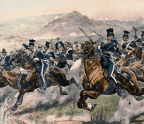

In the 1976 war film Shout at the Devil, based on the best-selling 1968 novel by Wilbur Smith and starring Lee Marvin and Roger Moore, a pair of ivory poachers are induced to wage guerrilla warfare in German East Africa during World War I. The climax of the film comes when Marvin and Moore board the German cruiser Blücher—hidden far up the Rufiji River while its crew repairs battle damage—and place a time bomb in the forward magazine, blowing up the ship.
The story is very loosely based on an actual incident involving the German light cruiser Königsberg, whose captain did steam the cruiser up the Rufiji in 1914 to overhaul its engines. Unable to get its capital ships within range to engage the cruiser, the Royal Navy enlisted the aid of noted hunter and scout Philip Jacobus Pretorius, one of South Africa’s most legendary figures. Pretorius helped the British find and destroy Königsberg. While nearly forgotten in naval history, the action is mentioned in English author C.S. Forester’s classic 1935 novel The African Queen.
(“His Majesty’s Ship”) was the lead ship of four light cruisers built by the Imperial Shipyard Kiel in 1905–06 to serve as fleet scouts in Germany’s home and colonial waters. Commissioned into the in 1907, was assigned that June to escort Wilhelm II’s yacht on a cruise of the Baltic and North seas, during which the kaiser met with cousin Tsar Nicholas II of Russia. For most of the next five years served as an escort or goodwill ship on visits to various European neighbors. It also undertook a series of reconnaissance patrols in the Mediterranean, thinly disguised attempts at spying on the British bases at Gibraltar, Malta, Alexandria and Suez. Placed out of service in Danzig for 19 months of modernization work, rejoined the fleet in January 1913. With a displacement of 3,400 tons and a length of 378 feet, drew just over 17 feet of water. The cruiser’s crew of 14 officers and 308 enlisted men operated the ship and its main armament of 10 4.1-inch guns on single pedestal mounts. Each gun had 150 shells at the ready, giving the was able to chase down any merchantman afloat. With two triple-expansion reciprocating engines driving twin propellers, the cruiser boasted a range of nearly 6,000 nautical miles. Its only limitation was the frequent need to coal.




